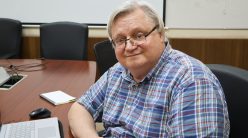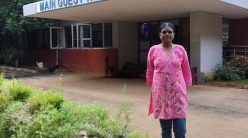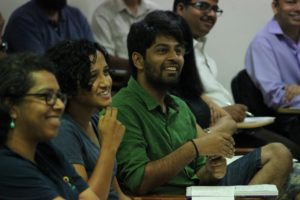
What is the nature of science? How do we learn? How can we use storytelling to communicate science? These were some of the many questions that participants – graduate students, postdocs and faculty members – grappled with at a workshop titled Science Pedagogy and Communication held in IISc on 26 and 27 May 2017.
The workshop was conducted by Meena Balgopal, Associate Professor at the Colorado State University (CSU), specialising in science education, along with Maria Thaker and Kartik Shanker, both faculty members at the Centre for Ecological Sciences (CES). It was organized through a grant called “Partnering to Sustain India’s Biological Diversity in the Context of Rapid Environmental Change: Research, Education and Community Outreach” to facilitate the exchange of faculty and students from CES with those from CSU. The grant is part of the 21st Century Knowledge Initiative which seeks to build partnerships between Indian and American institutions of higher learning.
After the workshop, Balgopal (MB) and Thaker (MT) sat down with Connect for a freewheeling chat about the workshop, their own journeys as teachers, and a host of issues related to pedagogy and science communication. Here are excerpts from the conversation:
Maria, how and why did this workshop come about?
MT: It’s a combination of luck and my interest aligning. Paul Ode [Balgopal’s husband], also from CSU, had come down to Bangalore a few months ago and I got to know about Meena and her work in science education through him. This was brilliant news to me because I am passionate about teaching science, and have been trying to sneak in different ways to communicate more effectively in the classroom. So I thought it would be great to bring Meena here and do a workshop.
“…I am passionate about teaching science, and have been trying to sneak in different ways to communicate more effectively in the classroom. So I thought it would be great to bring Meena here and do a workshop”
Meena, how did you get interested in science education?
MB: I’m trained as an insect physiologist. I took a break from graduate studies when I had my family. But I still wanted to stay in touch with academics. And I did that through science education. I would work part time in the science education department of a university or teach in a high school. I realized that students, both high school and undergraduate students, often developed misconceptions. That was when I got intrigued by how to help them resolve their conceptual difficulties.
So I went back to graduate school and sought permission to write a science education dissertation. They were initially hesitant, but they eventually agreed. However, they insisted that I study student learning at the same university so that it would help the students.
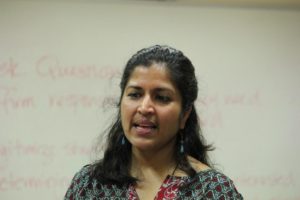
Could you tell us a bit more what you ended up studying and what you found?
For my dissertation, I studied the misconceptions of graduating Biology seniors in evolutionary biology. I wasn’t concerned with the relationship between religious upbringing and misconceptions in evolution because that’s where most of the research is done. I was interested in their conceptual confusion within biology, and so that’s how I entered the field which was really growing at that time in the US. I was mainly interested in documenting at what point students develop their misconceptions. So I did a lot of interviews of students, had them write essays and gave them problems which they had to do and then explain their solutions to me. And it turned out that writing is what helped them identify this confusion. As I said in the workshop, writing allows people to see what they know and don’t know. And then they can say, “Oh, I know A, I know C, and now I know that B is missing.” That is an important first step in clarifying their misconceptions.
“…writing allows people to see what they know and don’t know. And then they can say, ‘Oh, I know A, I know C, and now I know that B is missing.’ That is an important first step in clarifying their misconceptions”
Out of curiosity, what was the biggest misconception they had?
MB: Their biggest misconception was about how biological variation in a population arises at a genetic level. This misconception cascaded and led to a lot of other misconceptions because an understanding of genetics is so essential to understanding evolution.
MT: What did they have a hard time with? That mutations accumulate?
MB: Understanding the role of mutations wasn’t as hard for them as understanding the role of crossing over. Genetic recombination during meiosis is something they learn in their first year biology class! But they ended up compartmentalising this information.
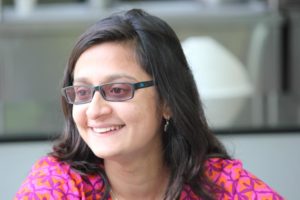
I’ll switch to some teaching-related questions now. And both of you can jump in at any point. What in your view is the role of a teacher?
MB: A teacher is someone who facilitates learning. In the workshop I challenged the participants to re-think what teaching is, and to reframe it so it’s not about one-way transmission. I wanted the participants to think about the process of learning and what the teacher can do to aid this – how they can create an environment conducive to learning, design curriculum based on the learning goals, and think about instructional strategies to support learning.
“I wanted the participants to think about the process of learning and what the teacher can do to aid this – how they can create an environment conducive to learning, design curriculum based on the learning goals, and think about instructional strategies to support learning”
And actually in meeting Maria, I learnt that she and I share this perception of teaching. That’s really exciting for me because I think we’ve both had very eclectic backgrounds. We’ve both moved a lot and studied at different places. She has moved across continents, and I, across different degree programmes. I’ve also jumped from natural to social sciences. And so we’ve had to be reflective about our own careers and about our own learning. This led me to reflect on questions like: what is it that we’ve needed as learners and how can we use that to help our own students?
MT: That’s right. I too think that teachers should be facilitators of learning. But I’m not surprised that our thinking and interests are aligned. If it didn’t, we wouldn’t be interested in doing a workshop like this. The traditional form of teaching which primarily involves talking to the students is outdated and not as effective. And it was obvious to me that I wouldn’t be an effective teacher if I just stood there in class, yacked at my students and expected them to absorb information like sponges. What I want them to do is learn how to think, ask the right questions, learn to design studies to answer their questions, learn to use information critically.
“What I want them to do is learn how to think, ask the right questions, learn to design studies to answer their questions, learn to use information critically”
MB: In principle this workshop could’ve been done differently – to cater to those interested in designing better PowerPoint presentations or multiple-choice tests. But that would’ve been very superficial.
MT: Oh yes, that’s right. That’s not the kind of workshop on teaching that I would’ve wanted.
One of the things emphasised in the workshop was to get participants to think of science not just as a noun, but also as a verb. Could you elaborate on this?
MT: Science is as much a process to me as it is a product. The product of science is the product of a good process. And so I emphasise this right from the first day of my undergraduate and my graduate classes. I seed them with this idea. I get them to ask questions and design studies to answer them. I discuss this with them in groups and often we catch each other’s mistakes. This allows them to troubleshoot their way through it while I watch and guide them. This is what I mean by facilitating learning.
MB: What I’ll add to that is that when you have a group of undergraduate students, we don’t know what they’ve experienced in their high school. We don’t know if they really understand the importance of inquiry in science. That’s the reason why it’s not a belief system that is stagnant and static. It’s not called science-ism. Inquiry is what pushes us to ask new questions and learn new answers. So it’s really important to emphasise this right at the beginning.
“Inquiry is what pushes us to ask new questions and learn new answers. So it’s really important to emphasise this right at the beginning”
MT: I say to my students repeatedly that most of what a scientist does is read, write and think (laughs). And spend very little time actually “doing” science. I say to them, “I don’t mind if you’re not at the lab bench all the time and are instead staring at the wall because that means you’re thinking.” Collecting data is the easier part. The fun part is the thinking and asking the right questions, and designing studies well.
MB: Yeah, an integral part of doing science is learning to reason.
MT: Before one runs around and stumbles through data collection, it is important to think about what data one needs to answer the question. Often PhD students and even undergraduates end up collecting data that don’t answer the question they are asking.
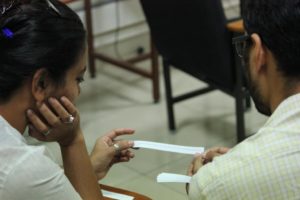
Scientists are expected to teach, at least most of them are. But teaching is not an essential part of their training when they go through graduate school and when they do their postdocs. I suspect you may have something to say about that
MT: Yes. I’m glad IISc has finally formalised a rule where PhD students cannot get their degrees without at least one semester of teaching as a TA [Teaching Assistant]. But my personal view is that it’s not enough. Still I think that this helps, especially if you can TA for a professor who will also involve you in lecturing and not just in doing the grunt work of marking assignments.
“I’m glad IISc has finally formalised a rule where PhD students cannot get their degrees without at least one semester of teaching as a TA [Teaching Assistant]”
Speaking about my own experience as a graduate student, I had a Research Assistantship. I didn’t have to teach. But I chose to teach because I wanted to get good at it and also because I enjoyed the process. I not only got a feel for teaching, but I also became a better scientist. There’s no doubt that I got cleaner in the way I thought about things since I had to explain it to someone else. And if I couldn’t do that it in the classroom, how am I expected to do that effectively in a conference or anywhere else?
Besides I think that we have to work on becoming better teachers because we have a responsibility to our students.
MB: I have a couple of things to add to that. I think professors in many graduate schools assume that their students are going to become professors in research institutions just like them. And they don’t encourage their graduate students to work on their teaching. Only now are we beginning to have a conversation that our job is not to train an army of “mini mes”. Just like in your own undergraduate classes, you don’t want to have a group of little Meenas or little Marias.
Another important reason why teaching is under-valued is because of the emphasis on research productivity and not on teaching when it comes to performance evaluation and promotion of faculty. So I think that there is bound to be some conflict for young assistant professors starting their careers about how much time and energy one can devote to teaching.
“Another important reason why teaching is under-valued is because of the emphasis on research productivity and not on teaching when it comes to performance evaluation and promotion of faculty”
Fortunately, there are a few good teaching universities where the focus is on student learning. And they encourage their students to do some research as well because they want their undergraduates to be competitive for graduate programmes in larger universities – they get their students to write grant proposals and do short research projects.
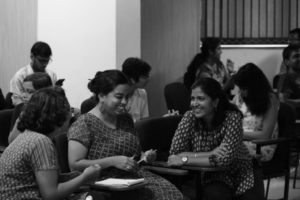
Let’s say that a new assistant professor is teaching an entire course at a college or university for the first time – not as a TA, but as the instructor of the course. How should they go about it?
MT: The first thing they should do is find out from students who they think gives good lectures and is a good teacher at that college or university. And then ask that person if they can observe their class. It’s also important to find out about what the culture at the university is and what the expectations are [with respect to teaching]. Find good mentors and good allies with whom you can talk about teaching.
“Find good mentors and good allies with whom you can talk about teaching”
MB: I completely agree. I think that we need mentorship programmes. We have professional learning communities (PLCs) in our professions – like our conferences – but we don’t necessarily have them for teaching. We need to have a platform where we meet regularly and share teaching resources. We need to observe each other teaching. The PLC can be formal or informal, but I think if we name it, then it becomes legitimized in the university. Then the administrators take notice.
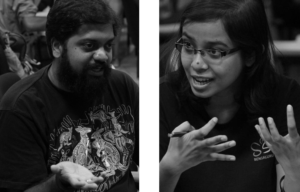
Meena, during the workshop, you talked about ways of engaging students. Could you tell us why you think it’s important?
MB: Engaging is an interesting word. We use it in lots of different ways. So I’m glad that you’re bringing it up. Engaging to me is really about how to keep the wheels turning and brain cells working. It’s really about getting the student to be an active learner. It’s just like you’re being an active listener now. As teachers we have to try to engage students by making what we teach more relevant to them and also give them opportunities to problem-solve. But we need to tell the students that we expect them to meet us half-way. The onus is on them as well to be willing to problem-solve, be reflective, and be active learners.
“As teachers we have to try to engage students by making what we teach more relevant to them and also give them opportunities to problem-solve”
Another term that was discussed at the workshop was prior knowledge and how it can either hinder or promote learning. A factor that influences prior knowledge is the socio-economic background that a student comes from. As a teacher, how do you deal with students who come from diverse backgrounds?
MT: With patience and flexibility. I don’t know what the official answer is, but that’s the way I’ve tried to deal with it as a young teacher – I’ve been here for about five years – teaching in India for the first time.
My first year was, I readily admit, frustrating. I was going through the curriculum somewhat rapidly, and trying to get students to upper-level Game Theory by the time I was done, and I was very wrong. I was new at this. And the students didn’t know me well enough. But mid-way through the semester, somebody said, “You’re going too fast. And we have no idea what you said for the last half an hour.” And so we paused and slowed down. They didn’t know that I wasn’t going to be the kind of teacher that ignores their discomfort. And I hadn’t articulated that well enough. But they soon learnt that they could talk to me anytime. I’m a different kind of teacher now than I was then. I’ve learnt to be more flexible. I’ve learnt that every batch is going to have a different composition and will be different. So I too have to be a learner.
MB: It is important to get to know our students and not assume that we know them. I have to constantly check myself to not have biases. For instance, I may have biases about students who may come from rural areas and quite a few of my students do come from farming communities in rural Colorado.
It’s also important to think about how best to get to know your students. So this last year, I spent a lot of time exploring ways to get students to come for office hours. I even had an undergraduate honours student who did a literature review on the effect of office hours on students and their performance. She found that it had the greatest impact on ethnic minorities. If they attended office hours, they were more likely to stay in science majors and get degrees in science.
MT: See, this is great. I do office hours anyway, but I didn’t know that there are data to show that it’s effective. This is why we need a community of teachers talking to each other.
MB: It may not have the same effect on all students. I don’t study office hours. I study logic, reasoning and misconceptions. I just happened to have an undergraduate student who wanted to do this. She is someone who is very quiet and she forced herself to get to know her professors. Her personal goal is to go to at least two office hours for every professor’s class every semester.
Now I have some of my office hours in the library which is more public. It makes some students less nervous. I ask them to come in pairs or groups if they feel better about it.
MT: Meena teaches huge classes. I have the luxury of teaching smaller classes. So I have an open-door policy, but I can see the value of scheduling designated office hours. In my classes, students do independent projects for which they’re going to want to talk to me anyway. And that’s when I get to know them.
“In my classes, students do independent projects for which they’re going to want to talk to me anyway. And that’s when I get to know them”
Meena, you discussed and even modelled for the participants different teaching strategies at the workshop: problem-based learning, group discussions, case studies and the like. Why would you recommend that teachers consider using some of these teaching strategies as opposed to only doing lectures?
MB: This is a question that I’ve heard from other people as well. It’s important to engage students in different ways. Nobody wants to eat the same meal all the time. But mixing things is important not just for variety. Each student is different. Not everyone learns from just listening to lectures, or from just doing hands-on activities. I don’t adhere to this principle that you have only one learning style. We know from literature that the idea that there are only visual learners or auditory learners has been debunked.
“Each student is different. Not everyone learns from just listening to lectures, or from just doing hands-on activities”
But at the same time we are comfortable using strategies that have worked for us. So I actually like to take the middle path. I usually do what is called an interrupted lecture. I will lecture for a few minutes, then pause and have perhaps a class discussion, and eventually return to the lecture. And that’s a compromise. Because students do need some information, they need to know what some of the big ideas are. At the same time, they also need some opportunities to grapple with things and identify their confusion or misconceptions.
At the end of the day, we need to have some level of consistency in our teaching style. Students need to know what to expect. So when I come into class, I’d let them know about what the learning agenda for the day is and this is how I’m going to present the material.
MT: The more that we break up the straight up PowerPoint lecture with something different, the better. Sometimes, I’ll say, “Let’s derive this equation on the board together.” This way students also learn the process and not just the information. So basically if we are actively involved in the process of teaching, we end up having a more energised classroom.
Meena also said some other stuff during the workshop that was valuable to me. It helped to reinforce my teaching style. She talked about little things like why it is useful to take some time to write on the board. And not turn your back to the students when you talk to them. Make eye contact. Build trust. Some of us do this naturally, but some of us have to work at it.
MB: One thing I didn’t say at the workshop is that I like to use proximity. I like to physically move towards the person who’s asking a question. And not just in the classroom, but in general. It helps to affirm their ideas and engage in a dialogue.
MT: I also like to have other people in the classroom try and answer a question that a student may have. I might say something like, “So what do you think?”
MB: At the workshop, by the end of the second day, I was sitting down when they were presenting, they were all asking and answering questions and I was thinking, “Oh, this is beautiful.” They were all engaged in trying to help resolve the problems that the presenters were addressing.
MT: When your class does it, it shows that people trust each other and feel comfortable enough to offer an answer.
MB: Absolutely. So some people like to talk about learning being teacher-centred or student-centred, and I like to use the term “subject-centred”. This means that we all own it. It’s not all about Karthik’s or Maria’s ideas. It’s about our ideas. It’s another reason I write on the board. It then becomes a collective idea. I found this easier to do that here – maybe because India has a more collectivist culture.
MT: Teachers should not assume that they have privileged knowledge. Just because I’m a professor it doesn’t mean that I have this secret knowledge that I’m going to hand down to you, and now you’re enlightened. I’m facilitating and organising that information, which is why I like to be very upfront with my students about my style of teaching, my expectations of them, what I plan to cover, and the resources that I will use. So it’s not privileged, it’s shared.
MB: What we’re describing is, in a sense, the apprenticeship model. We are masters and our students are apprentices who are on this journey that will help them become masters. This happens when we’re advising graduate students, but I think we should also do that with our undergraduate students.
“What we’re describing is, in a sense, the apprenticeship model. We are masters and our students are apprentices who are on this journey that will help them become masters”
In the workshop, you highlighted the difference between what you referred to as performance and understanding. How does one help students achieve both?
MB: From the teacher’s perspective, I can see how there can be a conflict between helping students perform and understand. I talk to my students on the first day of class itself about how understanding is different from performance. And that my goal is to help them understand. At the same time, I realise that the reality is that they need to perform well and score good marks to get into good professional schools or Master’s programmes. So I do share tips regularly about different strategies they should explore to increase their performance on exams, including on the standardised tests that they may have to take. But it doesn’t mean that there is no overlap between the two. You might be able to perform well and also understand well. However, I feel sad when students perform well, but don’t understand. To me, that’s not success.
“However, I feel sad when students perform well, but don’t understand. To me, that’s not success”
This is a good segue to my next question: what is the distinction between assessment and evaluation?
MB: These terms are used in very different ways by different people. In the context of student learning, assessment is a measurement of student performance. On the other hand, evaluation involves providing constructive feedback to the student. In principle, we can have assessments that have evaluative components. You can give marks and provide feedback at the same time.
There’s so much emphasis on assessments these days that we forget that the evaluation is what allows students to be reflective and actually take charge of their own learning. So if we only give marks without any feedback, then it is at odds with the philosophy that teaching is really about facilitating learning. The reality is that we need to have some assessment because we all teach at universities where we give marks.
But assessments can be useful in other ways too. We can have pre- and post-assessments to understand how well students have learnt, something I didn’t talk about in the workshop. Having different kinds of assessments will give students opportunities to know where they stand. I often use the analogy of learning to ride a bicycle. We don’t have just one or two chances to learn to ride it. So by giving students quizzes and different types of assignments, they have many opportunities to check their own learning. It also helps teachers because we can collect data to see what the majority of the class has understood or is struggling with. If I find that my students really don’t understand a concept like mutation-selection balance, I can spend a bit more time reviewing it.
Keep in mind that one can’t do all of these different kinds of assessments and evaluations. You have to ask yourself, “How do I maximise my output and minimise my input?” We have to think about this as a system, and so for me, it is changing a little bit each time. You don’t want to try too many new things at once.
“In the context of student learning, assessment is a measurement of student performance. On the other hand, evaluation involves providing constructive feedback to the student”
This ties in well the idea of Bloom’s taxonomy, a term that is used a lot in pedagogy, particularly in measuring learning outcomes. Meena, could you shed some light on it?
MB: Bloom’s taxonomy describes different hierarchical levels of cognition. It is a framework that teachers use. At the lower level – I say lower because it is less cognitive work – it has categories that have to do with remembering and understanding information. Then you have categories that require students to apply and analyse information. Let’s say you learn an equation, it is unlikely to become part of your long-term memory unless you have an opportunity to analyse and apply it in different situations. The highest cognitive levels, according to Bloom’s taxonomy, have to do with being able to evaluate and create new information. We don’t often push our students to do these high-level cognitive tasks because they really do require a lot of cognitive energy on the part of the students. But it is these higher levels of Bloom’s taxonomy that help us, through evaluating and synthesising information, to generate new knowledge. This is what we do as scientists.
“…it is these higher levels of Bloom’s taxonomy that help us, through evaluating and synthesising information, generate new knowledge. This is what we do as scientists”
I have a related question for you, Maria. I’m sure when you teach a course, you think about what cognitive skills students should develop at the end of the semester without necessarily thinking about it in terms of Bloom’s taxonomy. But do you think it helps to be conscious of this framework when you design a course?
MT: Very helpful! I knew about Bloom’s taxonomy, but I’d forgotten about it! So it was nice to be reminded. When Meena was talking about this, I sat there and saw those triangles with multiple colours and I said to myself, “Am I hitting all these spots? Do I have too much emphasis here and not enough here?” It made me self-reflect. And I spent two days during this workshop in the state of metacognition – something Meena talked about – reflecting on myself as a teacher.
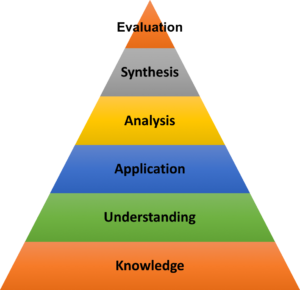
Tell us a little bit more about the importance of self-reflection for teachers?
MT: IISc has a student feedback form that’s now digitized. Students assess their teachers on a scale of 1-5. They are asked questions about whether the teacher did a good job, was the teacher prepared, etc. I don’t find it particularly useful as a teacher. So I have my own evaluation form in addition. I ask students questions about the topics I covered and what they found interesting and useful. I even ask them what they would change. I try to phrase questions in a way that gives me useful, targeted feedback. This allows me to reflect on my own teaching, which means that, every year, students get a better version of me. But if I just did an assessment based on the 1-5 scale with questions about whether I was good or not, it doesn’t give me the opportunity to change much of anything.
“This allows me to reflect on my own teaching, which means that, every year, students get a better version of me”
MB: Teaching is just like doing science – it’s an iterative process. We’re only able to move forward if we pause to find out what we’re doing well, what we’re not doing well and how we could do things better. And that’s why I called it scientific teaching.
And also, we’re modelling for our students. If we want them to be reflective learners, then shouldn’t we be reflective learners as well? We should constantly be learning about teaching and about ourselves as teachers.
Meena, what exactly did you mean when you talked about understanding by design during the workshop?
MB: The main point of understanding by design is that you think about your assessment before your learning plan.
Which is based on the goals you set…
MB: That’s right. You first say what your goals are and then decide on how you would assess whether these goals are met. After which you design your curriculum and instructional strategies. This ensures that teaching and assessment are aligned.
“You first say what your goals are and then decide on how you would assess whether these goals are met. After which you design your curriculum and instructional strategies. This ensures that teaching and assessment are aligned”
One final question. Tell us a bit about how the field of pedagogy has evolved in the past few years?
MB: It is becoming very rich. But in this field too there are people, like in any other field, who do pure basic research in learning and educational psychology. And it has moved away from being overly cognitive because science education is more than just what happens in one’s head. For instance, educational psychology has become more inclusive and includes socio-cultural theorists.
The field has more voices now. They have different perspectives. This ensures that it’s not only richer, but there’s also checks and balances when new ideas are brought in. I’ve been attending conferences in science education for the last 14-15 years. It has really become more diverse. There are more scholars coming from South Asia, African countries, and even the Middle East. The conversation is more global and we’re learning from each other. The other positive thing that has happened is that, at least in American universities, recruitment and retention of diverse students in science has increased. Now they’re also more likely to stay in the field after they graduate. And when I say diverse, I mean diversity in terms of gender, ethnicity, socio-economic status, geography. There’s a lot of work to be done, but I think there’s some progress.
MT: Yeah, the term science literacy came up quite often in the last couple of days. That is something that’s always at the back of my mind: how do we increase science literacy? Increasing diversity, not just among students but also among science educators, is important to increase science literacy in our society.




